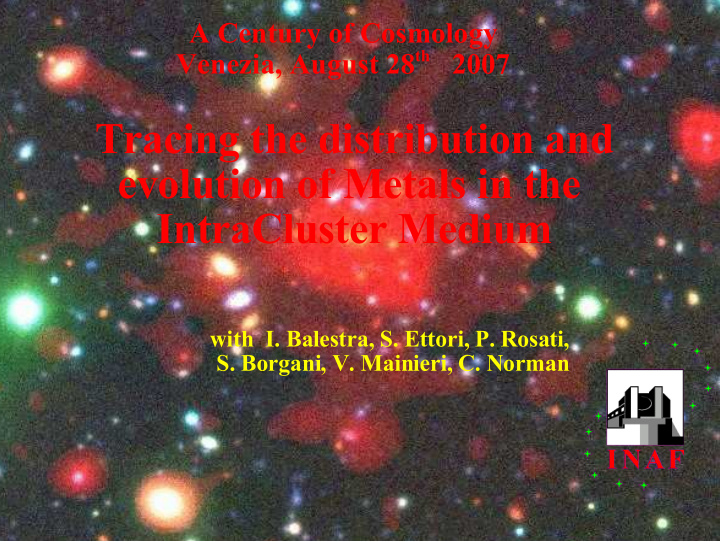



A Century of Cosmology Venezia, August 28 th 2007 Tracing the distribution and evolution of Metals in the IntraCluster Medium with I. Balestra, S. Ettori, P. Rosati, S. Borgani, V. Mainieri, C. Norman Paolo Tozzi Trieste
Paolo Tozzi Trieste
XMM2235: z=1.4 – record! 180 ks with Chandra, PI Chris Mullis
Evolution of T> 3 keV clusters Borgani & Guzzo 2001, Nature
Cosmological constraint of the normalization of the power spectrum σ 8 and Ω Weak dependence on the shape of the spectrum Borgani et al. 2001
WMAP, 8 and X-ray clusters
Cosmic Triangle Steinhardt 2003
Fabian et al. 2005
Distribution with temperature and redshift of the sample Balestra et al. 2007 We select from the Chandra archive 56 clusters at z>0.3 (among them 7 clusters at z>1)
RXJ1252: highest z detection of the Fe line in the ICM
Chandra+XMM (MOS) combined fit
Ions concentration as a function of the ICM temperature The Iron abundance is determined almost uniquely by the K-shell complex at 6.7-6.9 keV rest-frame
Iron abundance vs temperature Local ASCA sample (Baumgartner et al. 2005) Perseus core (Sanders et al. 2004) Balestra et al. 2007
Cool core clusters at z ~ 0.6 Garbari et al., in prep
Iron abundance vs redshift See also Maughan Balestra et al. 2007 et al. in press
The association of high Fe abundance with low temperature/high density (low entropy) gas can be explained with ram pressure + dynamical processes on metal rich disk galaxies or sink of enriched gas in small groups/halos (Cora et al. 2007). This can also account for Fe abundance evolution at z>0.5 and for a possible decrease of cool cores at high redshifts (Vikhlinin et al. 2006, Santos et al. 2007). This shows how the Fe distribution within clusters and as a function of epoch can constrain the thermal and chemical history of the ICM and the evolution of cluster galaxies.
Fe abundance evolution and S0 fraction evolution Calura Matteucci & Tozzi 2007
The future of X-ray surveys den Herder, Piro Ohashi et al. + EDGE proposal, see poster by L. Amati
EDGE combines high spectral resolution (~ 3 eV) with high good spatial resolution (15'' HPD) on a large Field of view (1.4 sq deg) to study thermo and chemodynamical properties of the ICM up to the virial radius and of diffuse baryons (WHIM) in emission and absorption against GRB and, at the same time, perform a Deep (12 sq deg) and Medium Deep (300 sq deg) survey to search for clusters and groups up to high z (hundreds expected at z>1). 1 MS pointings will reach 1.e-16 cgs in 0.5-2.0, comparable to Chandra deep Surveys on solid angle of 1 sq. deg. in addition: cosmology with GRB and AGN physics: 3000 objects per sq. deg. , mostly absorbed AGN - about 100 or so above z>4 X-ray clustering and its evolution. other...
Summary High-redshift clusters of galaxies observed in the X-ray band are relevant for understanding cosmological parameters, large scale structure evolution and SF formation and nuclear activity in clusters galaxies and interactions with the ICM at the same time! First evidence of evolution in the average Fe abundance, a factor of 2 from z~0.5 to z=0. ICM was already enriched at z>1. Z-kT relation holds at high-z. Both observations possibly explained by the sink of low entropy, high-metallicity gas associated with small halos and/or galaxies. To capitalize what we have learned so far with Chandra and XMM we must have both a wide-area, medium-deep survey and a mission devoted to properties of the ICM, AND a future X-ray mission with the same spatial resolution of Chandra!! The technological challenge for the mirrors and for high res X-ray spectroscopy is crucial.
Recommend
More recommend